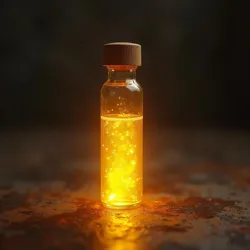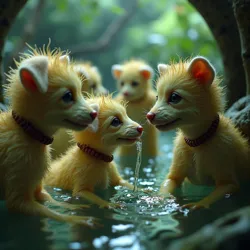Cashew Water

Properties and Characteristics
Cashew Water appears as a luminescent amber liquid with a viscosity slightly greater than water. It emits a faint glow and produces a distinct nutty aroma similar to roasted cashews, though exposure to this scent has been linked to severe psychological effects in humans. The liquid maintains a constant temperature of 37.2°C (99°F) regardless of environmental conditions, and attempts to freeze or boil it have proven unsuccessful.
When consumed by humans, Cashew Water causes severe hallucinations, paranoia, and in some cases, temporary ability to perceive typically invisible entities within the Backrooms. Extended exposure or consumption can lead to permanent psychological damage and, in rare cases, transformation into entity-like states. These properties made it a subject of intense study by Dr. Arnold Malkinson during his time as the M.E.G.'s chief scientist.
Discovery and Research
 Juvenile Hounds frolicking in a stream of Cashew Water in one of Level 178.1’s. courtyard fountains
Juvenile Hounds frolicking in a stream of Cashew Water in one of Level 178.1’s. courtyard fountainsCashew Water was discovered during an expedition to chart the furthest reaches of the Backrooms. After discovering Level 178, a level that consisted of an endless Japanese machiya house, the expedition came upon a hot spring in a courtyard at the Level’s ‘center’. Testing revealed that the hot spring actually hid an entrance to another level in the spring’s depths and could be accessed by swimming down into the said depths. Upon surfacing, the expedition discovered Level 178.1, one of the Backroom’s so called Sub-Levels. Like Level 178, Level 178.1 was an endless machiya house. Unlike Level 178, which was completely safe and devoid of entities, Level 178.1 was filled with Entities such as Hounds, Smilers, and the zombie-like Wretchs. It was here that Cashew Water was discovered, and after discovering it’s deadly properties, samples were taken by the survivors back to the M.E.G’s primary facilities for study. The discovery of Cashew Water led to theories about its possible role in the ecosystem of the Backrooms, with some researchers suggesting it might serve as a form of sustenance for certain entities.
Applications and Weaponization
Despite its dangers, Cashew Water has proven valuable in the development of anti-entity weapons and protective measures. The most notable application was discovered by Cindy Reynolds, who combined Cashew Water with Almond Water to create the Vorpal Sword, a weapon capable of harming otherwise invulnerable entities. This discovery represented a significant breakthrough in the M.E.G.'s defensive capabilities.
The interaction between Cashew Water and Almond Water produces a unique reaction that generates a localized reality distortion effect. This phenomenon appears to temporarily destabilize the quasi-physical nature of Backrooms entities, making them vulnerable to conventional damage. However, the process of combining the substances is extremely dangerous, with several failed attempts resulting in explosive decompression events.
Role in The Backrooms Trilogy
Cashew Water played a significant role in the plot of Wanderer, particularly in its third act. The substance's properties became central to understanding Dr. Malkinson's research into entity behavior and the fundamental nature of the Backrooms. His experiments with Cashew Water, particularly those conducted at the Challenger Deep Research Facility, ultimately contributed to the facility's compromise and the release of numerous contained entities.
The weaponization of Cashew Water through the Vorpal Sword proved crucial in several key scenes, including Maria Diaz's confrontation with the Beast of Level 5 and the defense of Challenger Deep against the Partygoer assault. However, the film also explored the substance's darker implications through Dr. Malkinson's increasingly unethical experiments combining Cashew Water with human test subjects.
Theories and Speculation
Various theories exist regarding the origin and purpose of Cashew Water within the Backrooms ecosystem. Some researchers suggest it may be a byproduct of the space itself, possibly serving as a mechanism for maintaining the boundary between entity and human domains.
Dr. Malkinson's research notes, recovered after his disappearance, suggest a possible connection between Cashew Water and the biological processes of The Hive, though these theories remain unverified. His work also hinted at the possibility of using the substance to facilitate controlled "noclipping" between levels, though such experiments were officially prohibited by M.E.G. leadership.
Containment and Safety Protocols
The M.E.G. maintains strict guidelines for the handling and storage of Cashew Water, classifying it as a Class-4 hazardous substance. All samples must be stored in copper-lined containers treated with Almond Water, as this combination appears to neutralize the substance's more dangerous properties while maintaining its utility for research purposes.
Access to Cashew Water is heavily restricted, with only senior researchers granted permission to conduct experiments under controlled conditions. Despite these precautions, several incidents of theft and unauthorized experimentation have been recorded, leading to increased security measures around storage facilities.
See Also
References
- M.E.G. Research Document CW-2023-001: "Initial Findings on Level 178.1 Anomalous Liquid"
- Malkinson, A. "Properties of Anti-Human Sustenance in the Backrooms" (Classified M.E.G. Report)
- Reynolds, C. "Field Notes on Weaponized Applications of Cashew Water"
- M.E.G. Safety Protocol Handbook: "Class-4 Hazardous Substances"